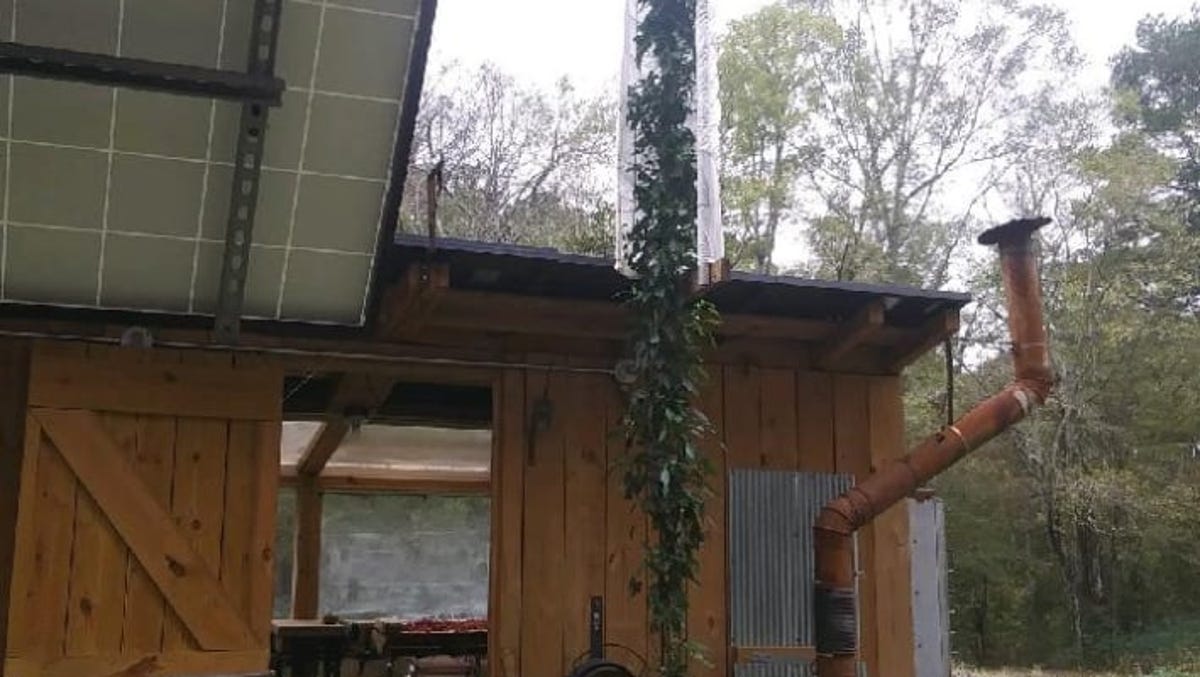North Dakota
Fielding Questions: Pineapple plant fruiting in ND, horseradish care, peat alternative

Q: I’d love to share some of the two pineapples I just harvested today in Mercer County, N.D, – Jessie Krieger.
A: When I hear of pineapple plants producing fruit, I visualize plantations in tropical Hawaii. And so, Jesse, you caught my immediate attention when you said you enjoyed homegrown pineapple in Scranton, N.D. I’ll let Jesse tell the tale.
“The photos are from August 2019 when I harvested my first pineapple fruit, which was about the size of a store-bought one. I started the plant from the top cut off a pineapple we purchased from the grocery store, and it took three years to grow the plant from start to finish.
Contributed / Jessie Krieger
“During the December before it fruited, I set a couple of ripening apples beside the pot and covered the very large plant loosely with plastic, which supposedly would trigger blossoming with the apple’s ethylene gas. It worked and by mid-January a spike with a tiny pineapple came up.
“The plant stayed in the house until May, and then went into my greenhouse. I fed it with Miracle Gro and by the end of of August, the fruit was fully ripe and very sweet.
“I then broke the top of the pineapple apart and rooted seven little pineapple plants from it. This set has taken the past four years to produce fruit, because the tops were so much smaller than the one I rooted the first time. All of this year’s fruit were a little smaller, but followed pretty much the same timeline – blooming in January after the apple ethylene gas treatment and ripening in the fall.
“The pineapple plants were repotted twice, going into a larger deck pot the last time. Each plant produces one fruit and several plant suckers at the base. “
Thanks, Jessie, for an inspirational story, and you’ve proven that pineapple tops can be rooted and brought to fruiting, even though the upper Midwest isn’t exactly the Hawaiian tropics.
Q: Is it okay to cut horseradish leaves down to a couple inches this time of year? They are getting pretty unsightly. – Todd B.
A: Horseradish leaves can be cut down in autumn to an inch or two above ground level, but wait until frost has killed the leaves, or the plants appear to be going dormant. The roots of horseradish make their greatest growth in late summer and early fall, and if the leaves look healthy, they continue to feed the roots.
If you’re planning to harvest the horseradish roots this year, delay digging until late October or early November. It can also be dug in early spring.
Q: I’ve been using peat-based potting soil for container gardening for over 30 years. Now I’m learning that peat moss is not a renewable resource, or at least in our lifetimes. What alternatives can you suggest? – Lisa P.
A: Peat has been a staple for most of our gardening lives, but because it takes over a thousand years to form about three feet of peat in a bog, we’ve been using it at a faster rate than it can possibly replenish.
Luckily there are good alternatives. For amending outdoor soil, compost and other organic materials work beautifully.
For potting soil and seed starting, coconut coir is a wonderful ingredient. It’s already being used in some national brand potting and seed-starting mixes. Compressed bricks of coconut coir can be ordered online and will probably become more readily available at garden centers.

North Dakota
Williston man hits off-road motorcycle in fatal crash

WILLISTON, N.D. — A 20-year-old Montana man was killed after a North Dakota man — who is accused of driving drunk — hit the off-road motorcycle he was driving.
According to the North Dakota Highway Patrol, the crash happened just after 5 p.m. Saturday, Feb. 1 at the intersection of Second Avenue West and Second Street West in Williston, North Dakota.
The Poplar, Montana, man was driving a 2020 Yamaha off-road motorcycle west on Second Street when 46-year-old Maverick Stanton of Williston attempted to make a turn onto Second Avenue West. Stranton, who was driving a 2004 Dodge Ram 1500, failed to yield and struck the motorcycle, the patrol said.
The Montana man was taken to Trinity Hospital in Minot, North Dakota, where he died.
Stranton was not injured. He was arrested for driving under the influence.
The name of the Montana man has not yet been released. The highway patrol said the roads were clear and it was sunny at the time of the crash.
Our newsroom occasionally reports stories under a byline of “staff.” Often, the “staff” byline is used when rewriting basic news briefs that originate from official sources, such as a city press release about a road closure, and which require little or no reporting. At times, this byline is used when a news story includes numerous authors or when the story is formed by aggregating previously reported news from various sources. If outside sources are used, it is noted within the story.
North Dakota
Who is Grey Zabel? What to know about North Dakota State football lineman after Senior Bowl

Grey Zabel might be the perfect player to prove the case for the Senior Bowl.
The former North Dakota State football offensive lineman has made a name for himself this week in practices and at the Senior Bowl game itself on Saturday. For his strong week at practices in Mobile, Alabama, Zabel was named the Senior Bowl Overall Practice Player of the Week in a poll by 32 NFL executives.
Zabel has worked into the conversation of being a late first-round pick following an intense week in front of NFL scouts and personnel.
Here’s what you need to know about Zabel, including his college recruitment:
Who is Grey Zabel?
Zabel measured at 6-foot-5, 316 pounds at the Senior Bowl. He appeared in 62 games during his career with the Bison, including starting at left tackle in his final season. He has proven he can play everywhere, as he also made starts at left guard, right tackle and right guard during his career.
During the Senior Bowl, Zabel played guard and got in a drive at center, further proving his positional versatility for the next level. Zabel graduated from NDSU with a major in agribusiness and a minor in economics and precision agriculture.
Zabel earned First-Team FCS All-American this season at tackle for the Bison, but being able to show his ability to play around the offensive line and the ability he creates with his hands and feet has earned him high praise from NFL draft analysts.
“From start-to-finish, Grey Zabel dominated the week,” ESPN analyst Field Yates wrote on social media. “He was outstanding in 1-on-1s at both guard spots and center. His hands and feet were always in sync and he finished with an edge. Leaving this week, Zabel felt like a guy who will hear his name called late in Round 1.”
Grey Zabel recruitment
- Star rating: 0 stars
- National ranking: No ranking
- Positional ranking: No ranking
- State ranking: No ranking
According to 247Sports’ Composite rankings, Zabel was unranked in the 2020 recruiting class out of T.F. Riggs High School in Pierre, South Dakota. Zabel also held offers from South Dakota and South Dakota State but committed to the Bison on July 16, 2019. He finished his high school career with 84 tackles, 25 t tackles for loss and 14 sacks.
North Dakota
Former Grand Forks lawmaker Corey Mock says appointment to Governor’s Cabinet was 'totally unexpected'

GRAND FORKS — No one may have been more surprised than Corey Mock when new North Dakota Gov. Kelly Armstrong asked him to join the administration as the state’s chief information officer.
Mock, who for years served Grand Forks as a lawmaker representing the Democratic Party, is one of 12 Cabinet members the incoming Republican governor announced shortly after the November election.
Armstrong’s invitation to serve “was totally unexpected,” Mock said, noting that it came after his “difficult” decision in early 2024 to not seek a fifth term in the Legislature.
The appointment apparently raised eyebrows in some strongly partisan sectors, but Mock said he has gotten nothing but favorable responses.
“I’ve only received messages of congratulations, and that’s from Republicans, Democrats and independents alike. It’s been quite evident that everyone agrees this is a nonpartisan office — there are no Republican and Democratic computers.”
Regarding his appointment, “I never thought of the political side of it until after I’d read one of the first articles,” said Mock, who served on the state’s Information Technology Committee for 16 years in the Legislature. “To me, this has never been a partisan position.”
From his perspective, political ideology is the “last (consideration) in this role — or any role, really,” he said.
“I’m an institutionalist, and proud of it. If anything, during my time in the Legislature, I became known for being stubbornly independent and focused on solving underlying problems, versus being a champion for a specific solution.”
As head of NDIT, Mock said his top priorities will be to ensure that, as an agency, “we continue to provide exceptional service.”
Mock, who served from 2008 to 2024 in the North Dakota Legislature — eight years representing District 42 and eight years representing District 18 — is obviously proud of the strides NDIT has made.
“We are the most connected state in terms of broadband access in the country,” he said. “It is an incredible accomplishment that’s taken decades of hard work and something that we should all be proud of.”
Among the most pressing challenges NDIT faces are issues related to cybersecurity, Mock said.
“We are one of the leaders in having a whole-of-government cybersecurity protection. You never want to need it, but when there is an incident, it’s so helpful having consolidated expertise that can step in and assist really every level of government.
“And technology is rapidly changing,” he said. “Looking at this session, we’ve got AI (artificial intelligence). … We know that there’s going to be some investments needed in AI — and waiting two years is probably not an option.”
Former Gov. Doug Burgum earmarked $15 million in the budget for AI-related grants, said Mock, who, in addition to his legislative experience, has built a career as a Realtor and leadership consultant.
He sees NDIT’s role as “not just helping with the technical questions, but that we’re anticipating future needs,” he said, “and making sure that, as we bring new technology in and we start making some investments and improvements, that we’re doing it strategically …”
During the summer and early fall, Mock reached out to colleagues, including appropriations committee chairpersons, returning legislators and both gubernatorial candidates, offering his help with any of the larger budgets he had worked on. He took this action “recognizing that we’re going to have some turnover – if there was anything I could do to help him or his team in the transition to get brought up to speed on where the Legislature had been. …
“From my perspective, that’s how a lot of this began — just offering to be a resource to him and his transition team as they were heading into the legislative session,” Mock said.
In a conversation in mid-November, Armstrong asked about Mock’s plans after his term ended “and quickly pivoted to, ‘I want you to run IT for me,’” Mock recalled. “It was totally unexpected — a true, I’d say, stunning response. It kind of set me back on my heels a bit, not even thinking that was even in the cards.”
After mulling it over for a few days, “I called him back and said, ‘I don’t have a compelling reason to say no. I serve at the pleasure of the governor; if you want me to join your team, I would be honored.’”
The appointment “speaks so highly of Kelly Armstrong wanting to build the right team,” Mock said. “Kelly puts his trust in his team (and) wants to put the right people in the job and let them do their job.”
“I think it’s heartening to see an elected official on a party ballot, so someone who represents a major political party, to look past the labels and to put people on his team that he knows and trusts regardless of their own political affiliation,” he said.
The origin of North Dakota Information Technology can be traced to 1969, he said, when it – as Central Processing — was part of the Office of Management and Budget, Mock said. In 1999, as the result of an interim legislative study, it became a separate agency — and, with that, a chief information office position was created.
Mock, the state’s ninth chief information officer since 1999, said he expects to be “out in the public and working with our team members and our agency clients as frequently as possible. I think that’s going to help us better understand what we can do to help improve state government and make sure that we’re using our resources efficiently and effectively.”
He intends to gain a first-hand understanding of how the workflow operates, he said.
As for the possibility of moving his family to Bismarck — the Mocks have three young children — that is something the couple will consider after the legislative session ends in the spring, he said.
He and his wife will make the decision, Mock said, based on “what makes the most sense for them — and for us.”
-

 News1 week ago
News1 week agoHamas releases four female Israeli soldiers as 200 Palestinians set free
-

 Business1 week ago
Business1 week agoInstagram and Facebook Blocked and Hid Abortion Pill Providers’ Posts
-

 Politics1 week ago
Politics1 week agoOklahoma Sen Mullin confident Hegseth will be confirmed, predicts who Democrats will try to sink next
-

 Culture6 days ago
Culture6 days agoHow Unrivaled became the WNBA free agency hub of all chatter, gossip and deal-making
-

 Nebraska1 week ago
Nebraska1 week ago3 years of the Nebraska Examiner: Looking back for inspiration and ahead to growth, with your help • Nebraska Examiner
-

 World1 week ago
World1 week agoIsrael Frees 200 Palestinian Prisoners in Second Cease-Fire Exchange
-

 Technology4 days ago
Technology4 days agoMark Zuckerberg says Meta isn’t worried about DeepSeek
-

 Business3 days ago
Business3 days agoTulsi Gabbard Defended Russia and Syria. Now She Must Defend Those Views.






















